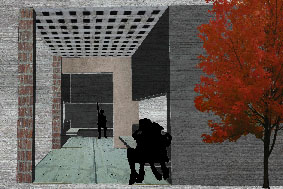

Throughout this dissertation we aim to the development of an elementary school, as well as a kindergarten according to the principles of anti-authoritarian education.
In order for our school-project to serve these principles (freedom, self-development, interaction) and to face the child as an individual, autonomous personality and as a vital member of society, our school holds a neighboring place with a wide range of uses that are targeted towards the community. These applications include sports facilities, a library, a large amphitheater, and a central square/plaza. Thus, the students are given the chance to use these spaces (with or without supervision) either simultaneously with the public, or at different times.
The Library holds a prominent role in this project, since it is through the library that we intend to attract the public, and it is also the role of the library to be the link between the school and society in general. In other words, the Library is the place where these two spatially distinct environments meet and interact.
The spaces that are targeted towards the general public, consist of simple, distinct, compact masses, grouped around a public square (which is located at level 0). In order to facilitate public access towards the central square and the other uses and create a “flow” from the city towards the complex, we suggest that Ath. Lefkaditi road (which is located next to the complex) will be turned to a pedestrian road.
The School area is distinguishable from the rest of the functions, since it is characterized by a high degree of complexity. This complexity (that follows the principles of the freedom of movement and choice, as well as the principles of the freedom of expression and appropriation of space) occurs with the repetition of four types of classrooms, that have being allocated in such a way, so that the outdoor space is being organized in the formation of small yards. The same logic on the organization of the uses around a central square that is applied in public spaces, is applied in the school area as well. However, the school area is designed on a different scale, due to young age of the students. This difference of scales allows the children to appropriate these spaces and their possible uses without the constant fear of supervision. That way, the children have a large number of choices of movements and uses that they can learn to utilize in any way they consider appropriate.
The classrooms’ interior is being organized with the intention to encourage the appropriation of space. Within predefined areas of functions (individual/group work, outdoor courses), these classrooms provide both students and staff with a wide range of organizations and activities. Furthermore, we have included in their design certain transitional areas that will allow students to express themselves, to present their work and to define their own “area of dominance». In this way, we aim to the creation of microenvironments that can function as the mean that will convey consciousness from the “I” of the classroom and individual work, out to the “We” of the open spaces, and of the collective action.
The aim of all our aforementioned suggestions is to move as far away as possible from the current authoritarian models of school organization. Namely, those that perceive the courtyard as a space devoid of functions, and the corridors as a means to control instead of promoting communication. Instead, in our project, children are given the chance to mature, to become independent and learn to discipline in an environment that they respect, and that contributes to their development. An environment that is not a fear factor, but rather an incentive towards the responsible undertaking of various activities.
Supervisor: Trova Vasso
Reference Number: 364


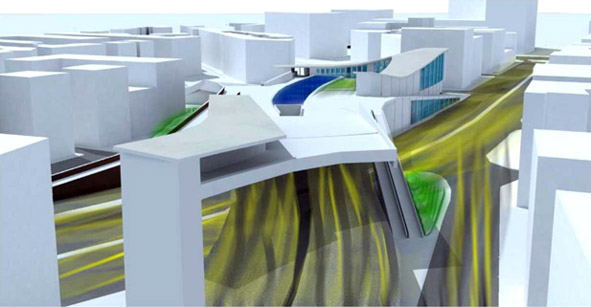



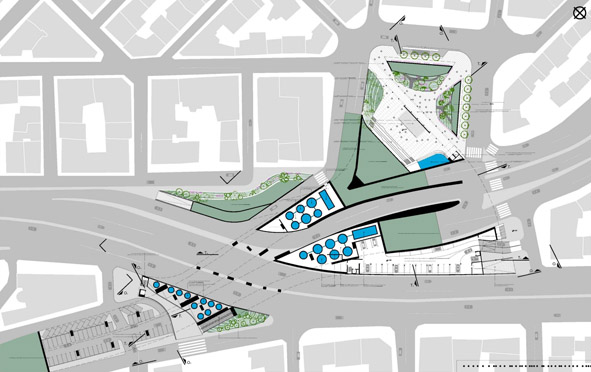



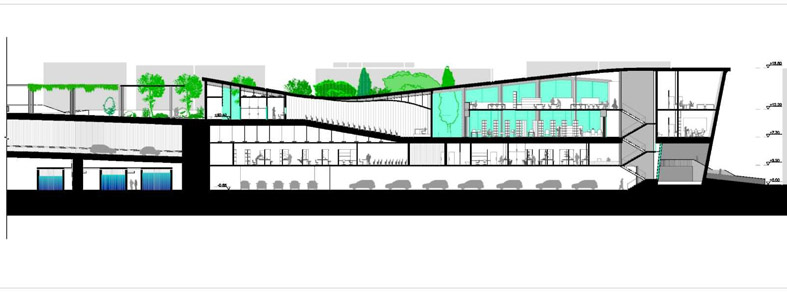

Public-ness and the limits it poses through fragmented road networks form part of an urban void which can, within proper restructure and creative construction, transform itself from a deterrent boundary to a limitless space, from a gap to a communication bridge.
It is exactly this kind of an in-between space that formed part of the current paper. Aim of the current project is to concern the reader with regards to the unification of the ‘past’ and the ‘future’, offering life in present, unification through combining three central road networks, with many ‘left-over’ and ‘out casted’ spaces, and turn it into a vital centre which will offer both a ‘lung of greenness’ for its residents but also an entertaining and educational centre for the visitor, covering basic communicational needs and shaking down the limits offered by the existing planning of the above mentioned networks.
The suggested project is situated in a central area of the capital between three main high – speed avenues. Its history shows us that this place was once full of life and water, before it turned into a speed passage and a limit line for the intersected areas. The water life of the Ilisos River gives the seed of creation both to a water centre, with a small exhibition hall, and to the revitalization of the greenness for the affluent shore fields of Ilisos. The suggested recast offers the reader the ability to monitor the way with which the ‘crack’ and the ‘void’ of these spaces in-between is replaced with vital areas for the urban landscape, like a multileveled square – park, a water museum as well as educational spaces connected to water issues and (hydroponics) cultivation.
Finally, the current project desires to set a debate for changes and rejection of limits and boundaries promoted by the modern lifestyle of immense urban models through its effort to improve this condition in the centre of a capital where the existence and rehabilitation of the public areas becomes more and more a compulsive necessity.
Supervisor: Papadopoulos Spiros
Reference Number: 391


The idea of a new archaeological museum, came after a visit to the existing Museum where the exhibits of stagnation due to lack of exhibition premises.
The space for the new Museum was based on the idea of continuing the ancient walls and towers surrounding the Piraeus, near the entrance of the port of Zeas, where in ancient times hosted 196 triireis in newsoikoys on the coast. The Museum's relationship with the sea, is to create a repository – newsoiko, which is both a wall and Tower.
The elevation difference of the area helped the terrace of the Museum to operate like a square, but as a continuation of the road linking regional ancient wall.
The Museum has permanent and periodic reports rooms, offices, library, maintenance workshops, warehouses, coffee and a small amphitheatre.
A minimalist form was chosen for the Museum, with the aim of highlighting the exhibits and not the function of the building as an exhibit. The aim is to create a firewall on the beach, which divides into two parts and causes a person to cross.
Important role have the patios of the Museum, open and closed, both for lighting and ventilation, and the sight from the level of exposure to the level of roof.
The tower at the end of the Museum serves as a secondary entrance-exit from the Museum, coffee and observation and small periodic exhibitions since it can operate independently from the rest of the Museum when it is closed.
Supervisor: Kanarelis Theoklis
Reference Number: 384






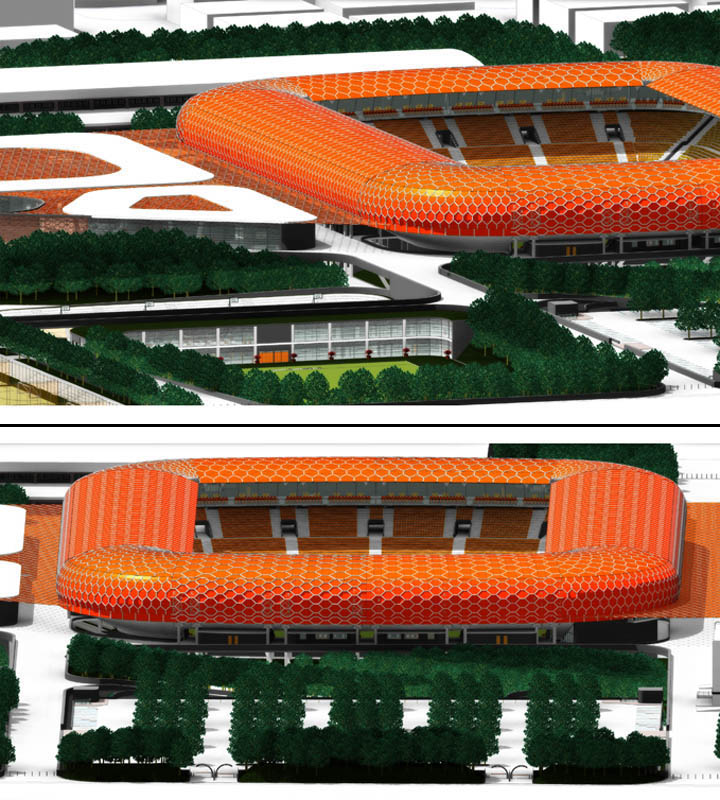

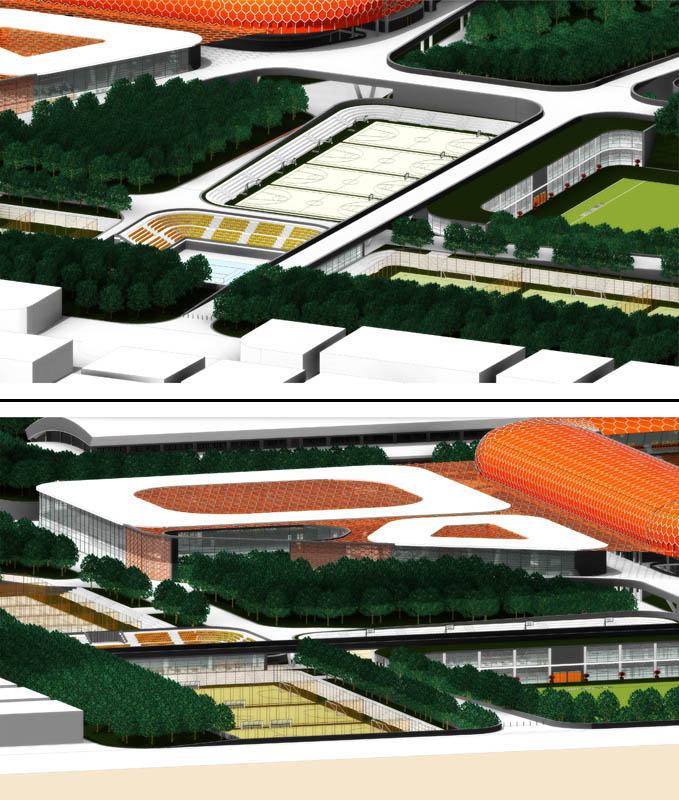

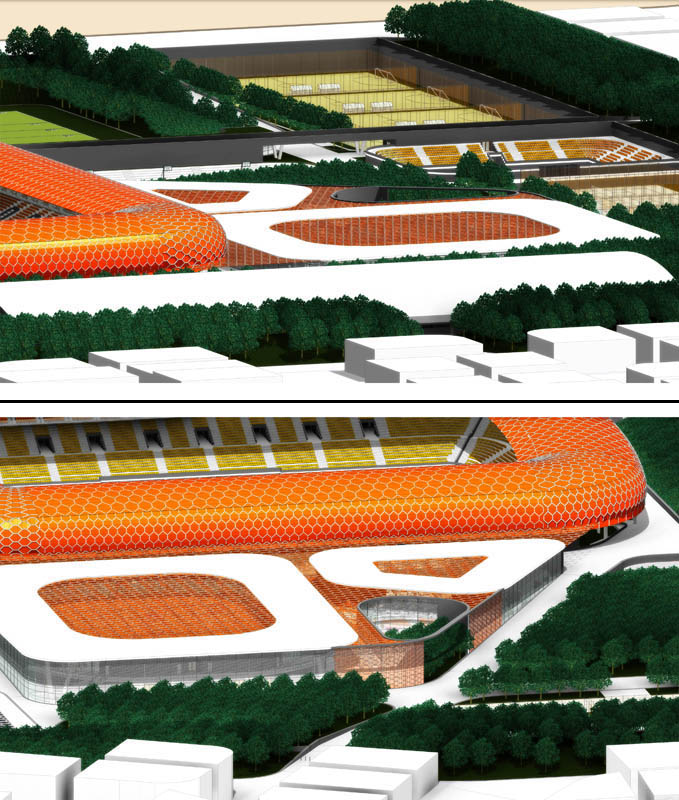

The object of this study is to create an integrated design proposal for the construction of a new sports centre for the Cypriot athletic team of APOEL (Athletikos Podosferikos Omilos Ellinon Lefkosias – “Athletic Football Club of Greeks of Nicosia”), focusing on creating a proprietary football headquarters in Nicosia, where “Makareio Stadium”, in Nicosia, is now located.
At a first level, the proposal concerns a built-up gentrification and redesign of the location, giving a new aura to the area, by creating a central, regional park and, thus incorporating therein the various sports’ activities required.
The city of Nicosia, that has developed in only one axis, due to political circumstances, is suffocating and is developed in an unbalanced way, creating dead zones in older cores of interest. Knowing the tendency of the city to expand by leaving large “regional voids”, the proposal is responding to the exploitation of this “void” that the area of Makario and the municipality of Makedonitissa in general has to offer.
The area around “Makario Stadium” can be characterised as a mixed-use area, since the Cyprus International Fair is located on the northern boundary of the plot, while the other sides border with built-up areas. This fact leads to a more anthropocentric approach to the design that aims to the functionalism and the service of the residents in the wider zone. It is necessary for the residents to create regional parks that will operate as a visual ‘gateway’ from the structured web and that will revive parts of the city.
The design proposal could not also ignore the trend of the society, by recording the views of the citizens within the official referendum that took place on the part of the municipality, that concerned their opinion on the redevelopment of an old sporting space (old “GSP” stadium), inside the core of the city. The results highlighted the need and willingness of the citizens to create mainly new spaces of greenery, parking lots, low buildings and sports facilities.
Based on the trend of the society, the respect for the “neighbourhood” consists the basic principle for designing the proposal and is applied both on the general concept, as well as on the partial design of the open and closed spaces in order to enhance the image of the “neighbourhood”, and also to increase the free and communal spaces, in the benefit of the public interest and the quality of life.
The proposal includes the replacement of the current “Makario” Stadium with a football stadium, with a capacity of 18,000 spectators, designed based on the specifications of UEFA that will be used by the team for both football matches and training sessions. There is also a proposal for re-constructing a swimming bath, basketball, tennis and archery fields, building offices for the team, hospitality areas, shops and a parking building. Also, after exhortation from the CSO (Cyprus Sports Organisation), the current building offices of the organisation, the indoor stadium “Tassos Papadopoulos – Eleftheria” and finally, the training centre “Evangelos Florakis” are included and kept in the design.
Supervisor: Triantafillidis Giorgos
Reference Number: 411


The aim of this project is to re-design the park at Anauros in order to attract more people. The basic concept is the combination of curved and straight lines that signifies the contradicting qualities of the natural (curved lines) and artificial (straight lines) environment. The idea derives from the geographical features of the site focusing mainly on the contact of the site with the sea. Additionally the fact that this site was artificially constructed using materials from the ruins of the earthquakes the city suffered from during the 1955. In comparison with the today's existing "urban square", this new approach underlines the importance of the presence of the natural environment by extending and organizing the greenery. Moreover activities such as walking, cycling etc, are being encouraged with the designing of paved pathways that traverse the site. A number of spaces of different quality (size, density) such as forestry, groves, flower-beds, open spaces are being organized and placed according to the curved lines, which are based on the concept, and the straight lines which follow the existent lines of the city. The combination of these different qualities gives a vast variety of spacial experiences. The existent functional activities such as playground, cafeterias, auditorium are being preserved but relocated in order to be distributed all over the site so as to "invite" visitors to the interior. Furthermore, the groves have more than just aesthetic value as they add the activity of harvest that may attract the locals. The variety of plants and trees adds to the forth-dimensional feature of the design since the visual impact of the park is going to differentiate over the months (blooming season, harvest season etc)
Supervisor: Manolidis Kostas
Reference Number: 378


The basic idea of the project “Steps towards the water” is the pattern generated from the alleys of the historical web of Lefkada and its reconstruction, through an in-depth dialogue of the past, present and future. The designing principles of the project reinforce the poetic and literal transfer of this pattern in the lighthouse beach, in the entrance of the island, having as a link the path between these two areas.
The redesign and reconstruction of the particular cluster ought to have as a basic principle the respect on the values it entails, every intervention/ interference should converse, be assessed or even self-annulled in respect to the relations it configures.
More precisely, the channels of the city’s alleys, which would flow underground, are revealed in many points and the paving is organised in playful corrugations, configuring the breaches into “floating routes”. This approach interrupts their linearity, creating cuts in their surface and allowing the flow of the water to become observable. The designing principles restore the circulation of people and water through the city.
The pattern, which is a result of the floating routes, is transferred in the areas of the lighthouse and the beach and it is redefined in paths. This perception establishes the overall strategy of finding the circulation system, which allows the various proportions of stable and unstable surface, as well as the transition from the area with the highest use (city 100% stable ground) as biotopes with rich vegetation, sand, liquid element (100% unstable ground), with a variety of experiential divergences in the interval
By using the hidden, sullen beauty of the area, where nature asserts a piece from the urban infrastructure, the designing principles aim at reestablishing this route as a means of amusement. By altering the rules of cluster of nature and pedestrians/visitors, the strategy of weaving the natural environment blends organic and structural elements in an amalgam of varying proportion, which conciliates the dessert land/ the wild, the cultivated, the familiar/ the intimate and the hyper-social.
The linear experience of this new landscape that emerges is marked from the flow, the disorder/ diversion and a diverse worldliness, which preserves the mysterious and dessert character of the area, without underestimating its projected use and its popularity as a public/ open space.
It is proven that the aim of this specific approach, through the combination of the historic with the modern, is the creation of an artistic pole which will interweave the historical memories of the past with the developmental perspectives of the future, providing a solution to really important problems of the particular city- related to the historical memory, the regeneration and the finding of valuable space within the dense web of its centre. Besides, the ability of adaptable thought and action in the field of architecture is a solution providing for the satisfaction of the demands of the potentially evolving society.
Supervisor: Kotionis Zissis
Reference Number: 385
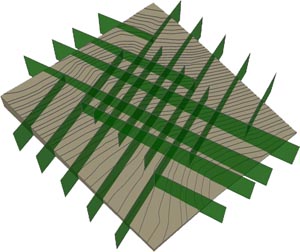

We live in an era where energy saving stops being a choice and is rendered need not only for ecological reasons but mainly for economic ones. In a country like Greece that our ecologic conscience is in deep sleep and our countryswirls in the hurricane of economic crisis and International Monetary Fund (I.M.F.), it is imposed we make our buildings greener. The urban web has become so much dense leading in isolation and the alienation. The spaces for the children to play with safety disappear and the need for walk and exercising is decreased after the bourgeois is forced to move in a environment full exhaust and cars.
For my dissertation I chose to make a proposal for energy saving in residential spaces, using the foundations of bioclimatic design, from the first stages of the planning. I tried to designee e group of residences that consumes the least possible energy taking in consideration the orientation, the way of manufacture, the placement of openings but also the role of user. I tried to create a system of residences and public uses, that green dominates, with enough spaces of concentration and communication, spaces of exercising, corridors for walking and riding a bike. A safe and healthy environment for children but also for adults, with a lot of activities.
We created 25 residences in the location Stauros Ftiotidas using external insulation, photovoltaic, proper orientation and green roofs. We also paid attention in the architectural planning creating similar buildings without however making them the same.
Supervisors: Tsangrassoulis Aris, Triantafillidis Giorgos
Reference Number: 372

